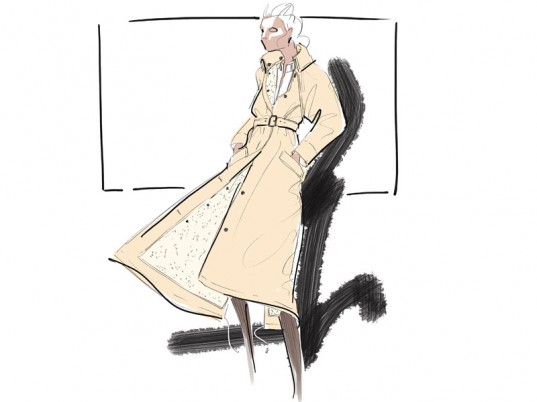Beyoncé recently announced that she plans to design a line of maternity clothes in tribute to her pregnancy.
Perhaps she didn’t hear the collective “ugh” that greeted Kanye West’s underwhelming debut collection at Paris Fashion Week. Maybe she also missed Lindsay Lohan’s tenure as artistic adviser to Emanuel Ungaro two years ago, a stint that euthanized the house’s reputation. It used to be that actors wanted to direct, but now all anyone with an agent wants to do is break into fashion – and the public and critical response is often scathing.
Remember Jennifer Lopez’s Sweetface line? No, of course you don’t.
West’s much-hyped debut was ugly. Despite boasts to “change the course of fashion,” his fur-centric spring/ summer collection featured shoes that appeared to be the guts of Ugg boots shaped into woolly doughnuts and stapled to high heels. These didn’t help the white plastic garbage-bag pants and tea-towel headpieces. The New York Times called the collection “utter nonsense,” while Vogue doyenne Anna Wintour, when solicited for her opinion, said, “Ask someone else.” But everyone else had already left.
Still, celebrities and fashion continue to be co-dependent and there are lucrative success stories amid the carnage. Jessica Simpson’s line, for instance, sold $750-million in 2010, while the Kardashian empire continues to grow, including clothing lines and a collaboration with the chain Bebe.
But the gains aren’t purely financial: Creative people can feel compelled to express themselves in a number of milieus. Judy Garland and Frank Sinatra successfully hopped between acting and singing. These days, the Olsen twinsand John Malkovich finally have something in common: well-received clothing lines they reportedly design themselves. This drive to shift artistic categories and constantly reinvent seems like a very American trait – individualism meets ego.
There’s something irksome, though, about blatant brand extension that lets dilettantes dabble in fields about which they know nothing. Bruce Willis’s ear-bleeding vanity albums served no one but comedians. For a strugglingfashion designer in a hyper-competitive business, watching an untested megalomaniac hip-hop star land a prime slot at Paris Fashion Week is surely infuriating, like being an actual milkmaid watching Marie Antoinette playing milkmaid. Kanye, beware: That didn’t end well for her.
While famous people may like fashion or dress well themselves, that doesn’t make them designers, which is an entirely different skill set. (Repeat: It’s a skill set.)
In the worst celebrity fashion unions, consumers sense fraudulence: Exactly how can these people be designing clothes in between red carpets and cleanses? Often, they don’t. Most celebrities are less designers than brand ambassadors, with endorsement deals that pass as creative expression. As far as we know, Simpson hasn’t designed so much as a sock; she simply licenses products that she and her mom deem worthy (a corporation called Camuto Group is the master licensee). The machinations of such arrangements were revealed last year when Zooey Deschanel had a falling out with shoe designer Steve Madden. Women’s Wear Daily reported that court documents stated Deschanel was originally supposed to receive a $2-million upfront payment for Madden to use her likeness and name, plus royalty fees.
So if you’re not buying clothes that the celebrities actually make, then you’re buying association and aura. Both Kate Moss and Victoria Beckham have been accused of ripping off designers in their own collections, but no one seems to mind. The appeal isn’t that they made the dress; it’s that they liked it.
But why exactly do we want to pay money for a piece of clothing that Julia Roberts endorses? Carl Raschke, a Christian cultural critic, told The Other Journal that celebrity fascination is a reflection of “cultural neuroses”: “We can’t stand the ambiguities of life, the fact that there doesn’t seem to be any obvious solution to our problems, so we tend to create a fantastic figuration or Being in our head – the Celebrity becomes everything we want to be.” Wearing a celebrity’s clothes, then, provides the sensation, no matter how false, of literally slipping inside the skin of the fantastic being.
Perhaps in troubled economic times, the generalist wins (see: James Franco). Covering all bases is a good strategy: If you don’t flourish in one field, there’s always another. Yet the cost of hyphenate creativity is expertise.
Kanye West’s disaster brings to mind former Torontonian Daniel Storto, who moved to the town of Gloversville, N.Y. several years ago. The quiet Adirondacks town had been the American epicentre of glove making until the middle of the last century. Over the years, the sewing machines silenced and the needle trades died. Gloves and single-skilled craftspeople went out of fashion and what desire was left could be met offshore. But Storto moved to Gloversville by choice and has become one of the world’s foremost glove experts, working out of a small shop on Main Street. Stitch by stitch, he makes his beautiful gloves, each singularly beautiful, one at a time.
